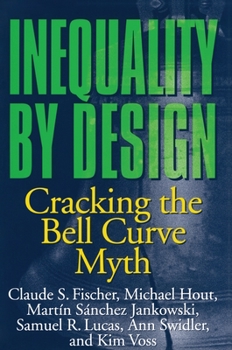Inequality by Design: Cracking the Bell Curve Myth
Select Format
Select Condition 
Book Overview
As debate rages over the widening and destructive gap between the rich and the rest of Americans, Claude Fischer and his colleagues present a comprehensive new treatment of inequality in America. They challenge arguments that expanding inequality is the natural, perhaps necessary, accompaniment of economic growth. They refute the claims of the incendiary bestseller The Bell Curve (1994) through a clear, rigorous re-analysis of the very data...
Format:Paperback
Language:English
ISBN:0691028982
ISBN13:9780691028989
Release Date:July 1996
Publisher:Princeton University Press
Length:384 Pages
Weight:1.10 lbs.
Dimensions:0.8" x 6.1" x 9.2"
Customer Reviews
3 ratings
Exposing the Bell Curve hoax
Published by Thriftbooks.com User , 15 years ago
"Inequality by design" is written by six sociologists based at the University of California, Berkeley. It exposes Richard Herrnstein's and Charles Murray's notorious "The Bell Curve", a bestselling book published in 1994 which argues that social inequality is based on hereditary intelligence and therefore inevitable. "The Bell Curve" also claims that Blacks and Hispanics are on average more stupid than Whites and East Asians. That such a screed could become a bestseller, apparently selling hundreds of thousands of copies, may say something about contemporary America. When I first heard about Herrnstein's and Murray's book, I assumed that IQ tests are legitimate, and that the distortion of "The Bell Curve" was simply that the book claimed that IQ was hereditary rather than learned. "Inequality by design" shows that the rabbit hole goes deeper, much deeper. It turns out that "The Bell Curve" is more or less a hoax, and so is the entire "science" of psychometrics it's based on! In an unguarded moment, Herrnstein and Murray admits that their measure of IQ only explains "less than ten percent and often less than five percent" of the differences in life outcome of the test takers. (Read that again, slowly.) In other words, more than 90% of the differences in life outcomes are *not* explained by the AFQT, the test used in "The Bell Curve" to measure intelligence! Their entire case is therefore bogus. Herrnstein and Murray created a mountain out of a molehill. Further, it turns out that the bell curve itself is an artificial construct. Psychometricians simply assume that the distribution of intelligence in a population is shaped as a bell curve. In reality, the individual test scores on the AFQT don't look like a bell curve - a substantial proportion of the test-takers answered all or most questions correctly. Indeed, 20% of White respondents got all answers right, but on the bell curve, only 5% are counted as "the cognitive elite". It also turns out that the very definition of IQ is problematic. IQ is simply what IQ tests measure - thus, a circular definition. Ironically, if IQ is defined in this way, it's impossible to explain why IQ scores have risen substantially after World War II, too short a period for genetic changes to take place (remember that Herrnstein and Murray believe IQ to be in large part heritable). "Inequality by design" also reveals what kind of questions the AFQT really includes. (The AFQT is a test administered by the US army to applicants.) The questions turn out to be high school level math and English questions, in other words, questions that measure how well the applicant has mastered a certain kind of curriculum. They don't really measure general intelligence. Of course, Herrnstein and Murray believe that how well somebody does in school is itself a product of hereditary intelligence. But that argument works only if everyone taking the AFQT has been exposed to the same curriculum in schools of the same quality, which is ha
Easy-to-read, yet academic, critique of The Bell Curve
Published by Thriftbooks.com User , 25 years ago
The numerous authors of this tome do a fine job in their criticism of Herrnstein and Murray. They discuss where those authors were correct, where they twisted stastics to meet their own goals, where they made false assumptions and where they committed bad science. This book doesn't get much into the genetic end of things, but rather discusses other causes of inequality and the flaws in the research of The Bell Curve. Recommended for anyone who wants a serious, scholarly, critique of pop science.
An excellent, thorough, accessible critique of The Bell Curv
Published by Thriftbooks.com User , 28 years ago
Fischer et al. launch a reasoned yet devastating critique on methodological grounds of Herrnstein & Murray's infamous _The Bell Curve._ The first half of the book details technical errors and ommissions from TBC, offering three distinct arguments against Herrnstein & Murray's basic claims, all using the same data they used in _The Bell Curve._ Then the second half of the book offers a substantive proposal for understanding income and wealth inequality in the United States, rooted in the same data Herrnstein & Murray used. Highly recommended.






